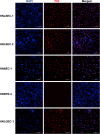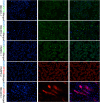Conditional reprogrammed human limbal epithelial cell model for anti-SARS-CoV-2 drug screening
- PMID: 38698981
- PMCID: PMC11064458
- DOI: 10.1016/j.heliyon.2024.e30044
Conditional reprogrammed human limbal epithelial cell model for anti-SARS-CoV-2 drug screening
Erratum in
-
Corrigendum to "Conditional reprogrammed human limbal epithelial cell model for anti-SARS-CoV-2 drug screening" [Heliyon Volume 10, Issue 9 , 15 May 2024, e30044].Heliyon. 2024 Aug 3;10(17):e35410. doi: 10.1016/j.heliyon.2024.e35410. eCollection 2024 Sep 15. Heliyon. 2024. PMID: 39958636 Free PMC article.
Abstract
To minimize the global pandemic COVID-19 spread, understanding the possible transmission routes of SARS-CoV-2 and discovery of novel antiviral drugs are necessary. We describe here that the virus can infect ocular surface limbal epithelial, but not other regions. Limbal supports wild type and mutant SARS-CoV-2 entry and replication depending on ACE2, TMPRSS2 and possibly other receptors, resulting in slight CPE and arising IL-6 secretion, which symbolizes conjunctivitis in clinical symptoms. With this limbal model, we have screened two natural product libraries and discovered several unreported drugs. Our data reveal important commonalities between COVID-19 and ocular infection with SARS-CoV-2, and establish an ideal cell model for drug screening and mechanism research.
Keywords: COVID-19; Cell model; Drug screening; Limbal.
© 2024 Published by Elsevier Ltd.
Conflict of interest statement
The authors declare the following financial interests/personal relationships which may be considered as potential competing interests:Wei Hou reports financial support was provided by Major Science and Technology Program of 10.13039/501100010877Science, Technology and Innovation Commission of Shenzhen Municipality. Shi-song Fang reports financial support was provided by 10.13039/501100012245Science and Technology Planning Project of Guangdong Province of China. Shi-song Fang reports financial support was provided by Science and Technology Program of 10.13039/501100010877Science, Technology and Innovation Commission of Shenzhen Municipality. No If there are other authors, they declare that they have no known competing financial interests or personal relationships that could have appeared to influence the work reported in this paper.
Figures










References
-
- Collaborators G.B.D.D. Global age-sex-specific mortality, life expectancy, and population estimates in 204 countries and territories and 811 subnational locations, 1950-2021, and the impact of the COVID-19 pandemic: a comprehensive demographic analysis for the Global Burden of Disease Study 2021. Lancet. 2024 S0140-6736(24)00476-8. - PubMed
LinkOut - more resources
Full Text Sources
Research Materials
Miscellaneous

